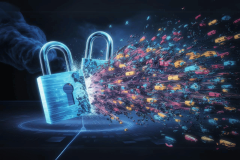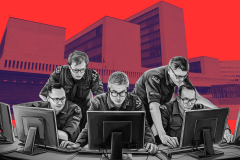Once an unusual employment arrangement, remote work has become commonplace in companies across industries and of all sizes, with 70% of the global workforce working remotely at least once a week, according to a 2018 International Workplace Group (IWG) study.
In response, an increasing number of organizations–particularly those wishing to attract Millennial talent–are allowing employees the flexibility to work outside the office.
It’s not hard to see why this work arrangement has become so popular. Remote work offers many benefits for both employee and employer. It allows companies to cut costs on office space, computers, electricity, and more.
As for employees, not only do 91% of remote workers report being more productive, but they’re happier too. In fact, 45% of remote workers report that they love their jobs — compared to just 24% of office-bound workers.
While there are many upsides to remote work, it also presents unique challenges.
Securing remote worker assets is a necessity but also an ongoing battle. Remote employee data and applications are accessed and utilized outside the umbrella of a corporate network. As a result, remote employees are exposed to many security risks — and likewise expose their employers’ data and systems to those risks.
Remote access solutions streamline how organizations provide data and application access to remote workers. But deploying these systems and maintaining them can prove difficult. In this article, we explore some common problems and how to address them.
Challenge #1: Installation, deployment, and management.
Remote access systems may comprise several layers: physical servers or hardware appliances, administrative software, and end-user software clients. And they must all play nicely together.
A significant investment of time and effort may be needed to deploy and manage the system, monitor and manage users and user access, and provide training so that internal staff can configure and maintain the solution. Moreover, these systems span many office locations and may also involve a hybrid setup including both on-premises and cloud-based machines running disparate operating systems.
And the work isn’t done once a remote access system is deployed. The systems must be maintained and administered. Someone in IT — perhaps the whole helpdesk staff — must handle troubleshooting and connectivity issues, patches and updates, and other ongoing maintenance tasks. Tickets must be managed. And all these overhead items add up quickly.
Handling routine user and resource management tasks for remote access can be challenging. This is true especially if the remote access solution does not provide a single, central management point.
The administration and management of these systems may require configuration changes across multiple servers, services, and software agents. Or, they may demand a mixture of client-side and server-side configuration. Both of these scenarios can lead to unexpected access outages, downtime during maintenance windows, and time-consuming troubleshooting efforts when things go wrong.
For remote access solutions that depend on virtual machines, management is often accomplished through a separate application entirely. If your VM administration interface does not integrate well with your remote management system, this can lead to everything from gaps in access reporting data to forgotten, unmanaged VMs. These scenarios hinder virtual desktop management efforts for IT personnel and expose business data to risks.
Solution:
Choose clientless remote access solutions that feature a flexible, unified management interface. If there’s no client-side software, then your staff need not expend resources to install or maintain it.
This allows your team to quickly provision access for remote users and branch offices anywhere. It also helps your business rapidly migrate workers to virtual desktops, manage their access, and perform administrative and management tasks – all without the need for local IT staff.
Opt for clientless solutions that provide remote access without requiring software to be installed on the endpoint device. Clientless remote access solutions have lower management costs, less downtime, and fewer security risks.
Choose a remote access solution that offers central management. The ability to facilitate access to physical or virtual desktops and hosted applications from a centralized location is more cost-effective and reduces the draw on IT resources. Administrators should be able to manage requests and access, as well as perform routine tasks for many users through one common portal.
Challenge #2: Scalability.
Ensuring remote access to networks and data is critical for remote employees’ ability to get work done. As noted, the remote workforce is growing rapidly — with between 80% and 90% of the U.S. workforce reporting they would like to work remotely, at least on a part-time basis. The ability to easily and rapidly scale a remote access system, therefore, is increasingly a primary concern for businesses both large and small.
Scaling up may involve standing up new servers or expanding network infrastructure and installing access management software. IT staff must be trained to handle and coordinate the deployment. New hardware appliances may need to be added to the network or OS update prerequisites and client software rolled out. The list goes on.
A reliable management system must not choke when scaled up to enterprise-level deployments. It must be able to handle sudden increases in remote access deployments (e.g., company acquisitions). An enterprise-ready remote access management system should be capable of scaling up to as many distinct client devices as a business is likely to need.
Solution:
Choose a remote access management system that will not only meet your current business needs but which is also capable of scaling up smoothly to handle increasing demand for remote access. The ability to rapidly onboard users across multiple geographic regions helps accommodate natural growth — without the growing pains.
Challenge #3: Functionality and ease of use.
Solutions for remote access problems tend to come in one of two varieties: flyswatters or bazookas. That is, they either lack the features necessary to support enterprise deployments reliably, or they’re “kitchen sink solutions” that overwhelm with their complexity.
Client-based remote access management systems may suffer from permissions issues or incompatibility with existing applications or work processes. This could result in lost productive time due to workarounds, retraining, or struggles to access the functionality they need. For example, according to an IDC survey on remote access security, more than half of IT professionals reported that adding new external user groups to their organization required over 10 network and application components.
At best, the negative user experience is an annoying distraction that can sidetrack normal work duties. At worst, your users may find themselves driven to circumvent the use of the remote access solution. The last thing you want is for your remote access system to be an obstacle to end users getting work done.
Solution:
Choose a solution you can customize and tailor to your organization’s specific needs. If you can choose only the features necessary for your users, you avoid overwhelming them with unnecessary and confusing options and procedures.
The remote access solution you deploy should be optimized for easy on-demand desktop access from any device, anywhere your users are. To keep your users working, make sure that accessing their data and applications is a seamless experience.
Challenge #4: Security.
Your remote access system must ensure that access to the data users need is fully secure. If, however, your system presents a direct connection to the internet, you’ve increased your risk. Direct exposure to the internet will dramatically increase your network’s attack surface. Among the 50% of remote workers who access company resources using personal devices, only half have antivirus or other security software on the device.
On another front, password-only authentication is no longer considered sufficient when security is a necessity. The 10th Verizon Data Breach Report linked 81% of data breaches to weak passwords. Thus, a remote access system secured only by a password is a prime target for attack and highly vulnerable to exploitation from password leaks.
Bear in mind that for remote access systems with on-device software clients, regular updates are essential to protect clients from vulnerabilities and exploits. Outdated, unpatched remote access clients are a valuable target for malicious hackers, and if breached, expose the organization’s data and networks to cyber attacks.
Solution:
Accessing remote resources via a secure gateway can reduce the inherent security risks. Also, two-factor authentication (2FA), the “gold standard” for securing remote desktop connections, can keep accessed data secure by ensuring user authenticity before providing access to remote networks and sensitive data.
In a Server-Based Computing (SBC) model, primary IT resources are installed and managed centrally on servers. This central hosting allows for secure, on-demand access to these resources. Besides being cost-effective and boosting productivity, by allowing administrative management from a central console, server-based solutions make it much easier to handle regular updates, which are critical to protecting organizational data from vulnerabilities.
Conclusion
The workplace is always changing, but one trend is clear: Remote work will continue to grow in popularity. Expect the requirements and standards for robust remote access systems to grow accordingly. The right remote access solution for your enterprise should:
- Offer on-demand access with no need for client-side software.
- Provide both privacy and security, with multiple flexible authentication options.
- Be cost-effective and generally contain operating costs through centralized management.
- Be customizable and adaptable to provide only the features your users need.
- Be easy to deploy, use, and manage.
- Be scalable to accommodate rapid growth.



















